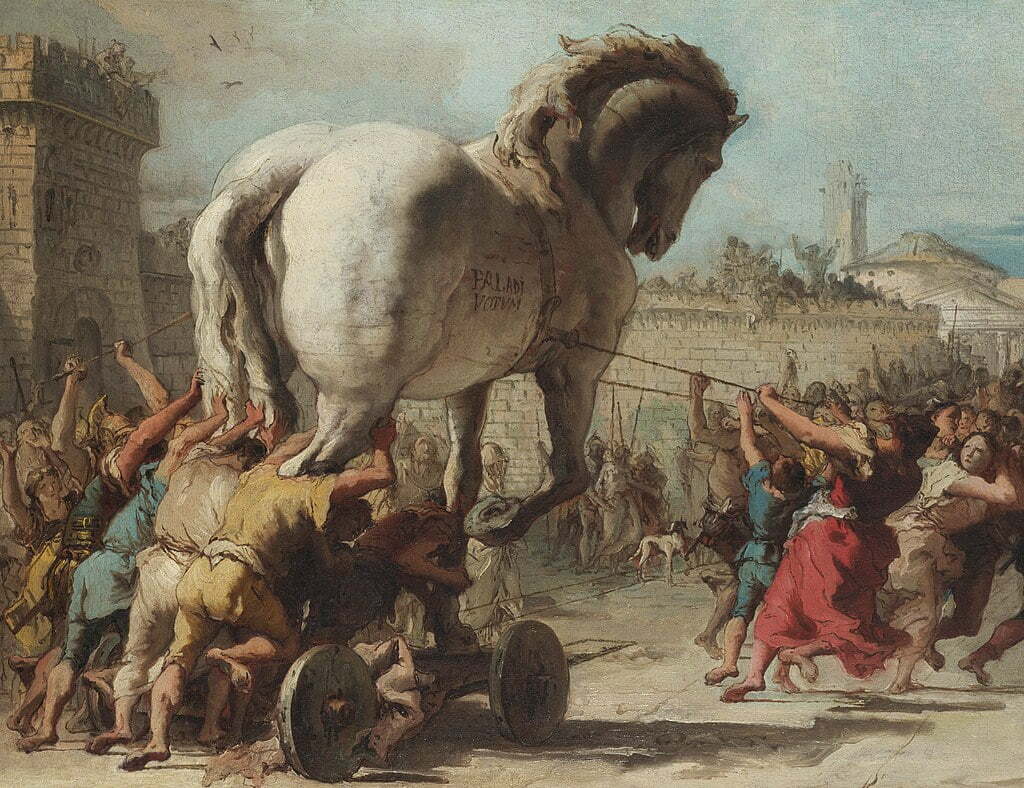Artifacts, Trojan Horse

The Trojan Horse is a tale from the Trojan War. The events in this story from the Bronze Age took place after Homer’s Iliad, and before his Odyssey. It was the stratagem that allowed the Greeks finally to enter the city of Troy and end the conflict.
After a fruitless 10-year siege, the Greeks constructed a huge wooden horse, and hid a select force of 30 men inside. The Greeks pretended to sail away, and the Trojans pulled the horse into their city as a victory trophy. That night the Greek force crept out of the horse and opened the gates for the rest of the Greek army, which had sailed back under cover of night. The Greek army entered and destroyed the city of Troy, decisively ending the war.
Legend
Odysseus came up with the idea of building a great wooden horse (the horse being the emblem of Troy), hiding a select force inside, and fooling the Trojans into wheeling the horse into the city as a trophy. Under the leadership of Epeios, the Greeks built the wooden horse in three days. Odysseus‘ plan called for one man to remain outside of the horse; he would act as though the Greeks abandoned him, leaving the horse as a gift for the Trojans. A Greek soldier named Sinon was the only volunteer for the role. Sinon successfully convinces the Trojans that he has been left behind and that the Greeks are gone. Sinon tells the Trojans that the Horse is an offering to the goddess Athena, meant to atone for the previous desecration of her temple at Troy by the Greeks, and ensure a safe journey home for the Greek fleet. The Horse was built on such a huge size to prevent the Trojans from taking the offering into their city, and thus garnering the favor of Athena for themselves.
While questioning Sinon, the Trojan priest Laocoön guesses the plot and warns the Trojans, in Virgil’s famous line “Timeo Danaos et dona ferentes” (I fear Greeks even those bearing gifts). However, the god Poseidon sent two sea serpents to strangle him and his sons Antiphantes and Thymbraeus, before any Trojan believes his warning. King Priam’s daughter Cassandra, the soothsayer of Troy, insists that the horse would be the downfall of the city and its royal family. She too is ignored, hence their doom and loss of the war.
Men in the horse
| Odysseus Acamas Agapenor Ajax the Lesser Amphidamas Amphimachus Antiklos Antimachus | Antiphates Calchas Cyanippus Demophon Diomedes Echion Epeius Eumelus | Euryalus Eurydamas Eurymachus Eurylochus Ialmenus Idomeneus Iphidamas Leonteus | Machaon Meges Menelaus Menestheus Meriones Neoptolemus Peneleus Philoctetes | Podalirius Polypoetes Sthenelus Teucer Thalpius Thersander Thoas Thrasymedes |

 Buy me a coffee
Buy me a coffee